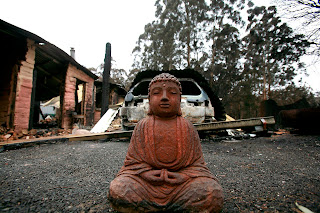
In place of our regular Regional Profile this issue, we have an incredibly moving account of one man's journey as he deals with the emotional aftermath of the Victorian bushfires that occurred this time last year.
I had to read Stephen Andrew's account in bits and pieces because his writing was so articulate and emotionally aware that I started to experience some of the emotions he was writing about and often became a little overwhelmed - it is such a wonderful, valuable piece.
He writes at the beginning of; "I didn’t cry during the fire weeks. Now, I am teary often. Oddly, abundance will set me off, like when I was deeply moved recently by a green grocer’s shop full of fresh produce. (“For me? Can I have this?”) Perhaps it’s another reminder that I didn’t die. The fires have pulled me much more into the light of the world. My eyes are struggling to adjust to the glow."
He writes about the various events that led him to healing and understanding, including a visit to his town by a group of Tibetan monks who created a sand mandala (we also have a wonderful article about such mandalas in the new issue) and ends with some further insight.
"I note the movement in my psyche over recent months. Post-fire, my mind is stronger, more direct and clearer when it comes to choice. Emotionally, I am more open and accepting, especially of my heart’s own peculiar beat. My soul seems a little softer. Abundance still makes me cry. Time, too, seems different: perhaps the present has asserted itself as a more dominant part of my life. I waste less time than I used to. Like the landscape of the Kinglake Ranges, the fire has revealed what was always already there. I am feeling my finitude and am more awake and more alive.
"My background in psychology takes me to Carl Jung’s fascination with the transformational fires of alchemy. Responding to detractors who declared alchemy to be fictitious, Jung said: “The alchemical operations were real, only the reality was not physical but psychological.” I think he is half right. This ancient and mysterious process had played itself out in an all too literal manner on Black Saturday and in the days that followed. In the fires, the physical and the psychological were deeply entwined. Months after the end of the fires, the environment and the people in it continue to change."
I write about all of this, not just to share with you a piece I'm proud to have in our magazine, but because the anniversary is likely to bring up many, many emotions. Some we will be able to experience then let go, some may be more powerful and difficult to deal with.
If you feel the need to talk, please contact Lifeline on 13 11 14 or visit their website www.lifeline.org.au. There are people there 24/7 who will listen and know how to help.
“In the immediate aftermath of a disaster, whether the floods or the bushfires, for many people the immediate need is survival; shelter, food, clothing and the like,” Lifeline Australia CEO Dawn O’Neil said today. “However, it can be many months later, even a year later, when they begin to feel the emotional impact of the event, and so when that happens it’s important to seek some support.
“Support can be speaking with a close friend or family member, a trusted colleague, a professional or a service like Lifeline. We have a 24 hour telephone support service on 13 11 14, as well as a range of online resources and discussion forums for people to utilise.”
www.lifeline.org.au
The issue with this article will be on stands February 17.
Image: Getty Images



